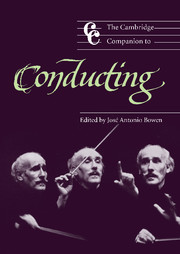4 - The conductor and the soloist
from Part I - Practice
Published online by Cambridge University Press: 28 September 2011
Summary
As a soloist, conductor, orchestra member, and conductor/soloist, I have had a unique opportunity to examine the relationship between the soloist and the conductor. During a long career, I have experienced collaborations between soloist and conductor that ranged from performances of great ensemble sensitivity and finesse to some that bordered on musical sabotage.
Conducting with a soloist differs in many ways from the norm, the most obvious difference being the expectations of the soloist and the orchestra. The soloist expects the conductor to embrace his or her interpretation without question. Discussions of differences should take place only in the privacy of the pre-rehearsal, as any evidence of disapproval by the conductor is very upsetting to the orchestra. The orchestra expects the conductor to be familiar with the soloist's interpretation and be technically prepared to indicate clearly any tempo changes or dynamic adjustments required. Any suggestions from the soloist should be given to the orchestra by the conductor! On one occasion a soloist chose to communicate directly with a wind player in the Boston Symphony Orchestra and this breach of etiquette caused an angry confrontation that required public apologies before we could resume the rehearsal. Vocal soloists expect the conductor to balance dynamics carefully so that they will not have to strain the voice. Singing full voice on the day of a concert is not to be expected of a vocal soloist.
- Type
- Chapter
- Information
- The Cambridge Companion to Conducting , pp. 40 - 44Publisher: Cambridge University PressPrint publication year: 2003



